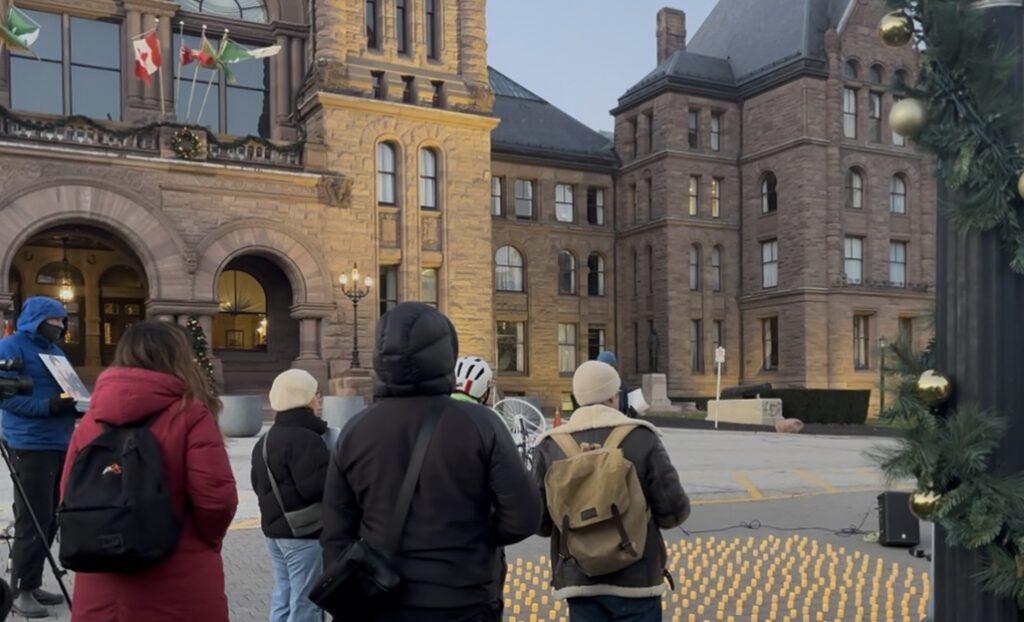
Listen to the whole story here:
Advocates gathered at Queen’s Park on Sunday for the annual World Day of Remembrance for Road Traffic Victims, honouring those who have been killed or injured in crashes.
616 candles were lit in front of the Legislative Assembly of Ontario, each representing a person killed by traffic violence in 2023. The vigil took place in the shadow of Bill 56, a new piece of legislation implemented on Friday by the provincial government, which bans the use of automated speed cameras across Ontario.
Titled the Building a More Competitive Economy Act (2025), the legislation reflects part of Premier Doug Ford’s push for new strategies to address speeding in the province.
The government says automated speed cameras have failed to slow drivers, citing the high volume of tickets issued as evidence. Instead, Ford’s party suggests that investing in physical infrastructure—such as speed bumps, raised sidewalks, roundabouts, and flashing signs with lights—offers a more targeted approach to reduce speeding in school and community safety zones where municipal speed cameras were previously deployed.
Ford says the policy shift is intended to protect drivers and taxpayers from what he describes as “cash grabs,” especially at a time when many Ontarians are experiencing financial strain.
However, Jess Spieker, the chair of advocacy group Friends and Families for Safe Streets (FFSS), warned that the bill stands to undermine protections for pedestrians, cyclists, and other vulnerable road users.
“For the second year in a row now, the people who work inside of this building–our provincial government–they’re waging an inexplicable war on road safety,” Spieker said at the rally on Sunday, speaking from the podium. “Last year, they tried to rip out our complete streets and have been blocked by the courts. This year, they just passed Bill 56, which was an omnibus bill that contained the poison pill of killing our speed safety camera program.”
Spieker emphasized that solutions to reducing speed-related accidents exist, but political action is needed to strengthen protections for road users.
“We know exactly what to do, and we have the resources to do it. We need our elected leaders to care–to start to value human life above corporate lobbyists and above driving convenience.”
For many supporters at Sunday’s event, the push for change has long been rooted in art-driven activism. Geoffrey Bercarich of Advocacy for Respect for Cyclists (ARC) has spent the past 25 years creating cycling memorials across Toronto.
His white-painted “ghost bikes” serve as public tributes to cyclists killed in traffic, installations that mourn their loss, mark the site of the crash, and call attention to the ongoing need for safer streets. Each bike is a reminder of the vulnerabilities cyclists face and a plea for greater respect from all road users—though Bercarich argues there is still more work to be done.
“One memorial is not enough, there are places out there that actually consider human life sacred and the province of Ontario is not one of those places,” Bercarich said. “It just simply trivializes and politicizes road safety. It plays like a weird election game where [it’s] motorists versus everything else.”
Bercarich says frustration over bike lanes, bus routes, and the transit system is growing, and he believes political rhetoric is fuelling division.
“[Ford is] catering to the motorist’s vote, and it really hurts people, it actually ends up killing people on the streets, and it creates this rage element towards other users of the road that aren’t in a car.”
For both advocates, what’s at stake for road safety measures is clear, extending far beyond political disagreements.
“It’s not abstract, it’s not academic,” Spieker said. “It’s who lives and who dies.”
Jenna Gitlin is a fourth-year journalism student and reporter for On the Record, Fall 2025
No AI was used in the production of this piece.

